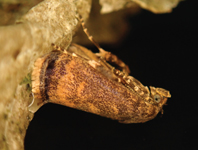Abstract
The genus Epsteinius Lin, Braby & Hsu gen. nov. is established to accommodate a new, diminutive species of limacodid moth, E. translucidus Lin, sp. nov., from central Taiwan. Although the new species is the sister taxon to Microleon Butler, 1885 according to molecular phylogenetic data, it differs fundamentally from that genus in adult morphology, wing color pattern, male and female genitalia, and larval morphology. Larvae of E. translucidus Lin, sp. nov. represent an interesting case in which crypsis is based on transparency through its body color, resting behavior, and feeding pattern.
References
Butler, A.G. (1885) Descriptions of moths new to Japan. Cistula entomologica, 3, 113–136.
Cock, M.J.W., Godfray, H.C.J. & Holloway, J.D. (1987) Slug and nettle caterpillars. The biology, taxonomy and control of the Limacodidae of economic importance on palms in South-east Asia. CAB International, Wallingford, 270 pp.
Epstein, M.E. (1996) Revision and phylogeny of the Limacodid-group families, with evolutionary studies on slug caterpillars (Lepidoptera: Zygaenoidea). Smithsonian Contributions to Zoology, 582, 1–102.
https://doi.org/10.5479/si.00810282.582
Hirowatari, T, Nasu, Y., Sakamaki, Y. & Kishida, Y. (2013) The standard of moths in Japan III. Gakken Education Publishing, Tokyo, 359 pp.
Kerfoot, W.C. (1982) A question of taste: crypsis and warning coloration in freshwater zooplankton communities. Ecology, 63 (2), 538–554.
https://doi.org/10.2307/1938969
Langsdale, J.R.M. (1993) Developmental changes in the opacity of larval herring, Clupea harengus, and their implications for vulnerability to predation. Journal of the Marine Biological Association of the United Kingdom, 73 (1), 225–232.
https://doi.org/10.1017/S0025315400032756
Lin, Y.-C., Lin, R.-J., Braby, M.F. & Hsu, Y.-F. (2019) Evolution and losses of spines in slug caterpillars (Lepidoptera: Limacodidae). Ecology and Evolution, 9, 9827–9840.
https://doi.org/10.1002/ece3.5524
Okano, M. & Pak, S.-W. (1964) A revision of the Korean species of the family Heterogeneidae (Lepidoptera). Annual report of the College of Leberal Arts, University of Lwate, 22, 1–10.
Powell, J.A. & De Benedictis, J.A. (1995) Biological relationships: Host tree preferences and isolation by pheromones among allopatric and sympatric populations of western Choristoneura. University of California Publications in Entomology, 115, 21–68.
Sasaki, A. (2016) A taxonomic note of genus Microleon (Limacodidae) in Japan, with descriptions of two new species. Japan Heterocerists’s Journal, 279, 99–106.
Sohn, J.-C., Kim, S.-S. & Choi, S.-W. (2018) Three species of Limacodidae (Lepidoptera, Zygaenoidea), new to Korea. Journal of Asia-Pacific Biodiversity, 11, 391–394.
https://doi.org/10.1016/j.japb.2018.07.006
Solovyev, A.V. (2008) The limacodid moths (Lepidoptera, Limacodidae) of Russia. Eversmannia, 15–16, 17–43.
Tsuda, A., Saito, H. & Hirose, T. (1998) Effect of gut content on the vulnerability of copepods to visual predation. Limnology and Oceanography, 43 (8), 1944–1947.
https://doi.org/10.4319/lo.1998.43.8.1944
Wang, H.Y. (1995) Guide book to insects in Taiwan (9). Bombycidae, Thyatiridae, Limacodidae, Lasiocampidae, Sphingidae. Shushin, Taipei, 283 pp.
Webster, R.J., Godin, J.-G.J. & Sherratt, T.N. (2015) The role of body shape and edge characteristics on the concealment afforded by potentially disruptive marking. Animal Behaviour, 104, 197–202.
https://doi.org/10.1016/j.anbehav.2015.03.027
Zaspel, J.M., Weller, S.J. & Epstein, M.E. (2016) Origin of the hungry caterpillar: evolution of fasting in slug moths (Insecta: Lepidoptera: Limacodidae). Molecular Phylogenetics and Evolution, 94, 827–832.


